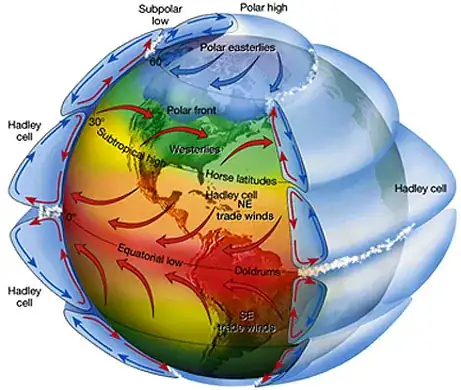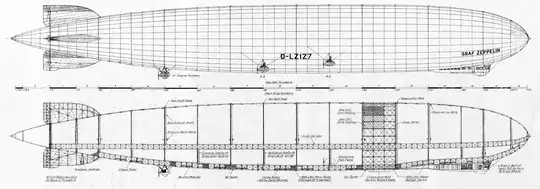It depends on how you fly it.
If you fly an airship like an airplane, you'll end up with efficiencies similar to those described by several of the other answers here. However, there are two factors that can be used in an airship to drastically increase the distance than can be travelled before needing to refuel:
- Airships don't need to expend energy to stay aloft
- Airships can control their buoyancy (to some degree).
These two factors allow us to do two things: use prevailing wind currents to move about and glide under gravity.
Moving about using wind currents
If your airships are willing to route themselves based on air currents, they can use these to float about without needing to consume power. For example, airships travelling between the US and Europe can use the trade winds when bound for the Americas and the prevailing westerlies when heading to Europe.
Of course, as you can see from a map of the Earth's wind patterns, these winds don't point directly from east to west:

This means we don't quite have a free ride, but we can still profit from using the winds, so long as the winds point at less than a 45 degree angle away from your desired destination. (At this angle, the amount of travelling you need to do to stay on course would be equal to the amount that the wind would push you.) The fuel savings from following the winds in this manner depend on wind angle. If your winds point away from your destination at an angle of 10 degrees, for example, you'll only need 1/8th the fuel you would need in still air.
If you want your airships to make there and back trips, you'll then have to fly from one air band to the other, or else break your airship down and ship it by train (or by ship) to its new takeoff destination. Of course, you can avoid this if you just keep going the same direction. The world is round, so you'll eventually be able to get back to where you started without needing to fight against the wind.
Gliding under gravity
If our airships are shaped in such a way as to be capable of generating a horizontal force from a vertical one applied to the airship by the surrounding air, i.e. if they have somewhat airfoil-like shapes, they'll be able to generate forward motion based on gliding. An airship can 'glide' by falling either up or down by changing its density, and then converting that falling motion to a forward motion using a wing. In many cases, the body of the aircraft itself can form the wing in what's commonly referred to as a hybrid airship.
In the simplest case, a moored airship can be filled with helium to a point where it is buoyant and then released, at which point it will float upwards (while gliding forwards) until it becomes neutrally buoyant. Upon reaching the apex of its climb, the aircraft can then begin releasing excess gas to begin its descent, again gliding forwards based on aerodynamic forces. Under the sea, this same concept has been used successfully to create underwater gliders.
While this sort of setup would only allow a limited distance flight (based on the amount of helium that could be safely released without crashing), it wouldn't require any fuel whatsoever. For longer flights, airships could rely on a steam-powered compressor to change their volume, and consequently their density. This, or using thermals to gain lift, could allow an airship to extend its travel times significantly, without relying on local wind patterns.

